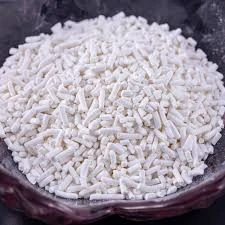
Understanding E477 Emulsifier and Its Applications in Food Products and Industry
Understanding E477 Emulsifier A Comprehensive Overview
The world of food additives can often be perplexing, filled with numbers, codes, and scientific jargon. One such additive, E477, also known as glycerol ester of fatty acids, is increasingly common in various food products. As consumers become more health-conscious, understanding the purpose and implications of such additives becomes essential.
What is E477?
E477 is an emulsifier derived from glycerol and fatty acids. Emulsifiers are substances that help mix ingredients that typically do not blend well, such as oil and water. In the food industry, they play a crucial role in promoting the stability and texture of food products. E477 is particularly valued for its ability to enhance the consistency and shelf life of various foods.
Uses of E477 in Food Products
E477 is widely utilized in the food sector. You can find it in margarine, creams, sauces, and baked goods, contributing to a smooth texture and preventing separation of components. For instance, in margarine and spreads, E477 helps maintain a homogenous mixture, ensuring that the product remains spreadable and appealing over time.
Another common application of E477 is in the production of chocolate and confections, where it minimizes the likelihood of fat bloom, a visual defect that occurs when fat rises to the surface of chocolate. By stabilizing the emulsion, E477 contributes not only to the shelf life of the product but also to the overall sensory experience, enhancing the mouthfeel and appearance.
Health and Safety Considerations
e477 emulsifier

As with many food additives, the safety of E477 has been evaluated by numerous health authorities, including the European Food Safety Authority (EFSA) and the U.S. Food and Drug Administration (FDA). Current assessments indicate that E477 is generally recognized as safe when consumed in moderation as part of a balanced diet. However, like any additive, excessive consumption could raise concerns regarding dietary health, particularly for individuals sensitive to certain components.
One point to consider is that E477 is derived from glycerol, which can be sourced from both animal and vegetable origins. Therefore, for consumers who are vegan or have dietary restrictions, it is essential to be aware of the source of glycerol in E477, as it may not align with their dietary preferences.
The Future of E477 and Food Additives
As the food industry continues to evolve, the use of emulsifiers like E477 is likely to increase, especially with the growing demand for processed foods that retain quality and stability over time. Innovations in food technology may lead to new formulations of emulsifiers that are even more effective or derived from alternative sources, catering to various dietary preferences and restrictions.
Consumers are encouraged to read labels thoughtfully and stay informed about food additives. While E477 fulfills essential roles in food production, being aware of what we consume is a vital aspect of healthy eating.
Conclusion
E477, or glycerol ester of fatty acids, exemplifies the important role emulsifiers play in modern food production. As consumers, understanding E477 and its functions can aid in making informed dietary choices. While it is classified as safe by health authorities, moderation and awareness of food sources remain key components of a balanced diet. As we move forward in a world of ever-evolving food technologies, staying informed about the ingredients we consume remains paramount.
-
nitrile-rubber-honoring-strict-production-standardsNewsAug.22,2025
-
aspartame-ingredients-honoring-food-safety-valuesNewsAug.22,2025
-
fertilizer-for-balanced-plant-nutritionNewsAug.22,2025
-
cyanide-gold-processing-with-high-purity-additivesNewsAug.22,2025
-
formic-acid-in-textile-dyeing-applicationsNewsAug.22,2025
-
aluminum-hydroxide-gel-in-skincare-productsNewsAug.22,2025
-
Regulatory Compliance for Global Mining Chemicals UseNewsAug.12,2025
Hebei Tenger Chemical Technology Co., Ltd. focuses on the chemical industry and is committed to the export service of chemical raw materials.
-

view more DiethanolisopropanolamineIn the ever-growing field of chemical solutions, diethanolisopropanolamine (DEIPA) stands out as a versatile and important compound. Due to its unique chemical structure and properties, DEIPA is of interest to various industries including construction, personal care, and agriculture. -

view more TriisopropanolamineTriisopropanolamine (TIPA) alkanol amine substance, is a kind of alcohol amine compound with amino and alcohol hydroxyl, and because of its molecules contains both amino and hydroxyl. -

view more Tetramethyl Thiuram DisulfideTetramethyl thiuram disulfide, also known as TMTD, is a white to light-yellow powder with a distinct sulfur-like odor. It is soluble in organic solvents such as benzene, acetone, and ethyl acetate, making it highly versatile for use in different formulations. TMTD is known for its excellent vulcanization acceleration properties, which makes it a key ingredient in the production of rubber products. Additionally, it acts as an effective fungicide and bactericide, making it valuable in agricultural applications. Its high purity and stability ensure consistent performance, making it a preferred choice for manufacturers across various industries.





